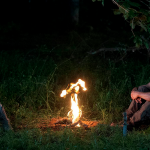This is the second article in our series on Suzanne Collins’s Hunger Games trilogy. It’s largely spoiler-free, but those who want to remain completely unspoiled might want to save it until after reading the book.
Ah, the adolescent love triangle—in the post-Twilight world of YA fiction, we must now pledge our allegiance to Team Edward or Team Jacob, Team Peeta or Team Gale, in spite of the fact that it’s generally clear who will win the heroine’s affections in the end. As a reader who was drawn to the Hunger Games trilogy because of its portrait of civilized barbarism—a televised competition in which children fight to the death—rather than its romantic angle, I feared that Catching Fire, the second book in the series, would focus too much on the constant wavering of Katniss’s affections between Gale, her “best friend,” fellow subsistence hunter, and budding revolutionary; and Peeta, her steady, self-sacrificing fellow competitor in the Seventy-Fourth Hunger Games.
Catching Fire does have a lot more going for it than just romance. In between the Seventy-Fourth and the Seventy-Fifth Hunger Games, dissatisfaction has built in Panem. Several districts are on the verge of rebellion against the Capitol, and Katniss finds herself the unwitting symbol of revolution (one of my minor frustrations with the book was just how unwitting Katniss seems to be—her slowness to catch on to certain plot points seems more a matter of convenience for the author than a believable element of her character). Meanwhile, the horror of the Games continues unabated—and, in fact, intensified, as it’s the year of the Quarter Quell, occurring every twenty-five years, in which the Capitol adds some extra sick twist (beyond the usual sacrifice of twenty-four children) to remind the districts of its power over them. Like the first volume in the series, Catching Fire moves at a quick and gripping pace.
And then there’s that love triangle, which I expected to find problematic. For one thing, it’s hard to imagine how a reader could possibly fall into the Team Gale camp, since Gale has never been fully developed as a character. Katniss constantly tells us how much she likes Gale, but almost always in flashback. He seldom appears within the present-moment narration, and when he does, he’s generally cranky or unconscious. His greatest redeeming feature is that he calls Katniss “Catnip.” Stack this up against the common bond forged by Peeta and Katniss surviving the horrors of the Hunger Games—horrors that Gale can’t begin to comprehend—and there’s really no competition. Peeta is the one who comforts Katniss when she wakes up screaming from a nightmare about the Games, and he’s the one who, upon learning that Katniss’s show of love for him during the Games was at least partly feigned, still treats her with dignity and compassion in spite of his personal disappointment. Plus, Peeta bakes bread and utters lines like, “Frosting: the last defense of the dying.”
Ultimately, it seems as if Suzanne Collins herself wasn’t particularly interested in the love triangle per se. It’s useful for developing some tension in Katniss’s and Peeta’s relationship, but Collins as an author doesn’t seem committed to depicting Gale as much of a threat. Is this authorial laziness? Perhaps. I like to think, though, that Collins, through the love triangle, has some bigger goals in mind—goals that are connected to the series’ gritty political side. Yes, that’s right—I have to admit that the romance plot may not be a distraction from the dystopian drive of the series, but rather an integral part of it.
In Catching Fire, Katniss begins to realize that she will have to carry on her pretense of being madly in love with Peeta—a pretense begun when he confessed his love (genuine, as it turned out) on camera during the Games—even to the point of marrying him, in order to appease the Capitol’s President, who suspects that Katniss’s actions during the Games might be motivated not by youthful infatuation but rather by deliberate rebellion against the Capitol. Katniss reflects, “One of the few freedoms we have in District 12 is the right to marry who we want or not marry at all. And now even that has been taken away from me.” In fact, one of the first things we learned about Katniss in The Hunger Games is that she planned never to marry: if she did marry, there would likely be children, and children would be entered in the lottery each year for the Hunger Games. Better not to bring children into a world where they could be forced into such atrocity.
Pause. Rewind a few centuries, from fictional Panem to North America, as it was once known. Specifically, the United States—then, not entirely united—in the year 1861, when a former slave named Harriet Jacobs published a narrative called Incidents in the Life of a Slave Girl. Jacobs’s narrative, like Harriet Beecher Stowe’s novel Uncle Tom’s Cabin a decade earlier, was primarily written to elicit the sympathies of northern white women on behalf of the abolitionist cause. In Incidents, Jacobs reminds her free readers of the emotional burdens connected to marriage and motherhood for a slave. When a free black man proposes marriage to her, and her master refuses consent, Jacobs writes,
“Even if he could have obtained permission to marry me . . . the marriage would give him no power to protect me from my master. It would have made him miserable to witness the insults I should have been subjected to. And then, if we had children, I knew they must ‘follow the condition of the mother.’ What a terrible blight that would be on the heart of a free, intelligent father! For his sake, I felt that I ought not to link his fate with my own unhappy destiny.”
What Jacobs captured so brilliantly was that the very experiences held as the epitome of virtuous nineteenth-century femininity—marriage and motherhood—were denied her. Was she also denied basic human dignity and personhood? Yes, and she does mention these things. But she knew that there were readers who would be more effectively moved by the reminder that she, a slave, did not have the freedom to love.
In Catching Fire, as well as in Incidents in the Life of a Slave Girl, romance becomes a political issue. Peeta, in particular, is able to use his “star-crossed lover” ethos to whip the superficial, melodrama-addicted Capitol audience into a frenzy of dissatisfaction with the Games. Even Katniss, though she resents the President’s mandate concerning her relationship with Peeta, realizes that that same romance can be the most powerful weapon in her anti-Capitol arsenal. One of the intriguing things about the Hunger Games trilogy is that, though Katniss wants the freedom to marry or not marry, it’s also clear that romance is never a purely individual choice.
Romance in literature, at its best, can be used as a powerful symbol to suggest what is wrong with the world. Of course, it can also represent what is, in spite of everything humans can do to mess it up, right with the world. There’s a reason that God chose marriage between Christ and the Church as the symbol of ultimate, eschatological hope (personally, I would have chosen frolicking puppies instead, but that’s just me and C. S. Lewis). Will romance also symbolize hope in the Hunger Games trilogy? For that, you’ll have to wait for the review of Mockingjay. Until then, I’ll unabashedly proclaim my Team Peeta allegiance.










